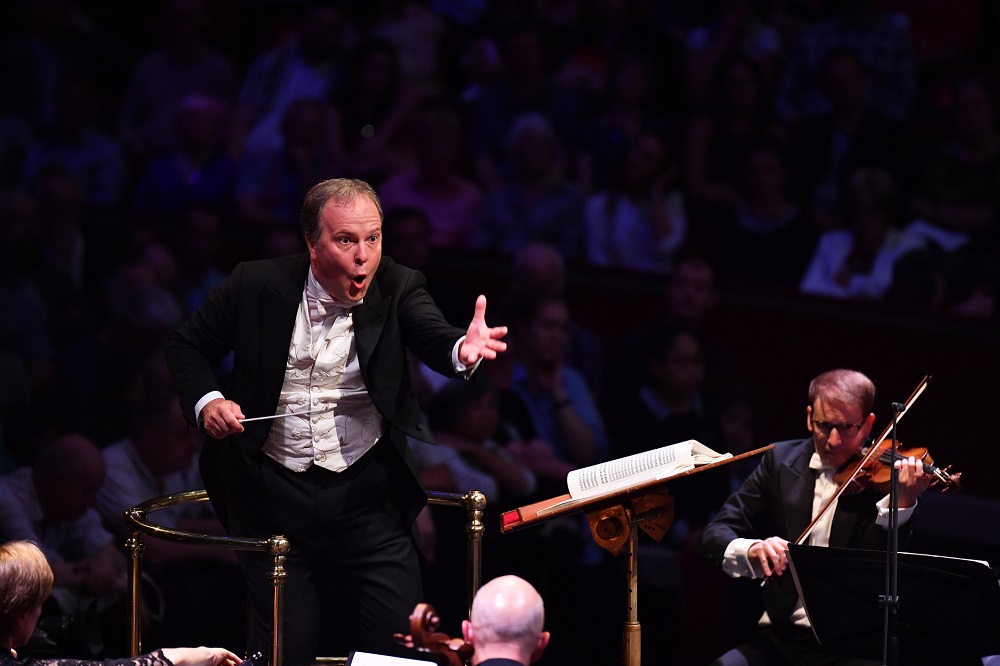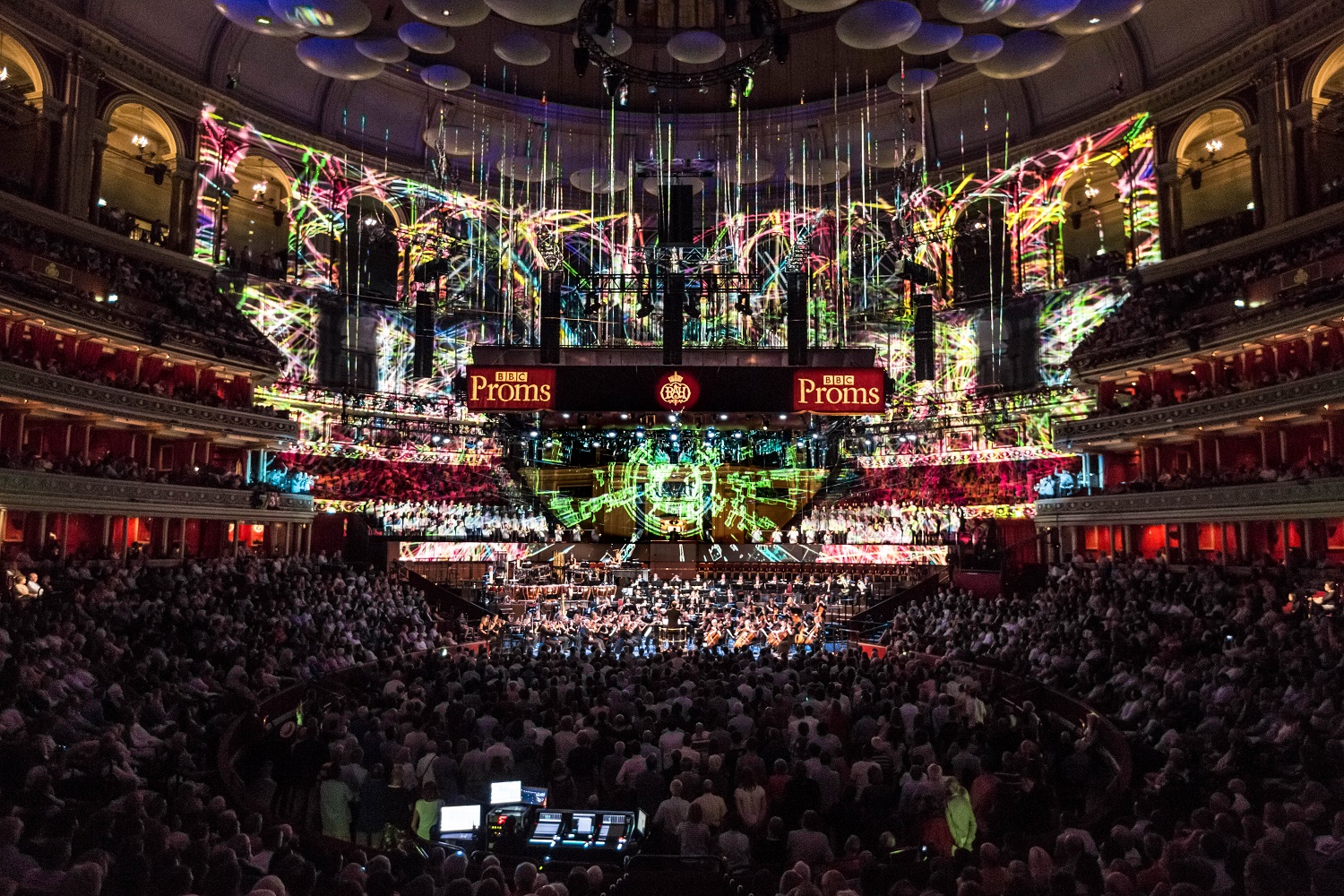Prom 1, BBCSO, Oramo review – spectacular First Night of the Proms | reviews, news & interviews
Prom 1, BBCSO, Oramo review – spectacular First Night of the Proms
Prom 1, BBCSO, Oramo review – spectacular First Night of the Proms
Dynamic but sensitive Holst, multi-media show high on spectacle but low on substance
The First Night of the Proms is always a tricky one to programme, bringing together themes of the season, perhaps a new work and, most importantly, a grand finale. This year’s Prom No. 1 ticked all the boxes, and without feeling like pick-n-mix.
But before all that, a hastily added memorial to Oliver Knussen, who died this week. Knussen was a regular at the Proms, so it was fitting to mark the occasion. In the event, his Flourish with Fireworks would have been the ideal concert opener, with or without his untimely passing. The piece is based on Stravinsky’s Fireworks and similarly short and punchy. It is more varied too, the flourishes of the title coming across as brief asides in different tempos and textures. The ever-prepared BBC Symphony took it all in their stride, with no hint of rushed preparation.
Toward the Unknown Region opens in a darker place, Vaughan Williams setting Walt Whitman, and both in sombre, funereal mood. The BBC Symphony Chorus were on top form here, giving us suitably dark and focussed choral textures, but also clearly articulating the words – just as well as there were no texts provided. Oramo marshalled his large forces efficiently and dynamically, suitably emotive but never sentimental. 
The Anna Meredith work was entitled Five Telegrams, and was written in commemoration of the centenary of the ending of the First World War. The work is a collaboration with 59 Productions, who provided a spectacular light projection, covering the stage, organ, choir stalls and all the space above, right up to the gallery (pictured below by Justin Sutcliffe).  The work’s five movements are entitled “Spin”, “Field Postcard”, “Redaction”, “Codes”, and “Armistice”, but beyond that, Meredith and co. took a highly abstract approach to their subject. Meredith’s music here is tonal and repetition-based, although not to the point of minimalism. She was also writing for the National Youth Choir of Great Britain and the BBC Proms Youth Ensemble, a group of teenaged brass and percussion players, some in the choir stalls, others positioned around the hall. And most effectively, one movement featured a choir of euphoniums, playing mellow chords up in the gallery.
The work’s five movements are entitled “Spin”, “Field Postcard”, “Redaction”, “Codes”, and “Armistice”, but beyond that, Meredith and co. took a highly abstract approach to their subject. Meredith’s music here is tonal and repetition-based, although not to the point of minimalism. She was also writing for the National Youth Choir of Great Britain and the BBC Proms Youth Ensemble, a group of teenaged brass and percussion players, some in the choir stalls, others positioned around the hall. And most effectively, one movement featured a choir of euphoniums, playing mellow chords up in the gallery.
The light show, all computer generated effects and patterns, sometimes including a single evocative word, was skilfully integrated into the architecture of the hall, illuminating the ranks of pipes inside the organ and, in one movement, transforming the arches of the gallery into huge turning cogs. The overall effect was grand, and perhaps a little upbeat given the subject. Meredith’s music was a component in this multimedia work, and the synergy between the light show and the music was close indeed. More substance might have tipped the balance better towards the musical side, especially to the contribution of the orchestra, but it all served its purpose: A memorable start to the season ahead.
- Watch on BBC Two and/or listen on BBC Radio 3 for the next 28 days
- Read more classical music reviews on theartsdesk
rating
Explore topics
Share this article
The future of Arts Journalism
You can stop theartsdesk.com closing!
We urgently need financing to survive. Our fundraising drive has thus far raised £49,000 but we need to reach £100,000 or we will be forced to close. Please contribute here: https://gofund.me/c3f6033d
And if you can forward this information to anyone who might assist, we’d be grateful.

Subscribe to theartsdesk.com
Thank you for continuing to read our work on theartsdesk.com. For unlimited access to every article in its entirety, including our archive of more than 15,000 pieces, we're asking for £5 per month or £40 per year. We feel it's a very good deal, and hope you do too.
To take a subscription now simply click here.
And if you're looking for that extra gift for a friend or family member, why not treat them to a theartsdesk.com gift subscription?
more Classical music
 Helleur-Simcock, Hallé, Wong, Bridgewater Hall, Manchester review - moving lyricism in Elgar’s concerto
Season opener brings lyrical beauty, crisp confidence and a proper Romantic wallow
Helleur-Simcock, Hallé, Wong, Bridgewater Hall, Manchester review - moving lyricism in Elgar’s concerto
Season opener brings lyrical beauty, crisp confidence and a proper Romantic wallow
 Kohout, Spence, Braun, Manchester Camerata, Huth, RNCM, Manchester review - joy, insight, imagination and unanimity
Celebration of the past with stars of the future at the Royal Northern College
Kohout, Spence, Braun, Manchester Camerata, Huth, RNCM, Manchester review - joy, insight, imagination and unanimity
Celebration of the past with stars of the future at the Royal Northern College
 Jansen, LSO, Pappano, Barbican review - profound and bracing emotional workouts
Great soloist, conductor and orchestra take Britten and Shostakovich to the edge
Jansen, LSO, Pappano, Barbican review - profound and bracing emotional workouts
Great soloist, conductor and orchestra take Britten and Shostakovich to the edge
 Jakub Hrůša and Friends in Concert, Royal Opera review - fleshcreep in two uneven halves
Bartók kept short, and a sprawling Dvořák choral ballad done as well as it could be
Jakub Hrůša and Friends in Concert, Royal Opera review - fleshcreep in two uneven halves
Bartók kept short, and a sprawling Dvořák choral ballad done as well as it could be
 Hadelich, BBC Philharmonic, Storgårds, Bridgewater Hall, Manchester review - youth, fate and pain
Prokofiev in the hands of a fine violinist has surely never sounded better
Hadelich, BBC Philharmonic, Storgårds, Bridgewater Hall, Manchester review - youth, fate and pain
Prokofiev in the hands of a fine violinist has surely never sounded better
 Monteverdi Choir, ORR, Heras-Casado, St Martin-in-the-Fields review - flames of joy and sorrow
First-rate soloists, choir and orchestra unite in a blazing Mozart Requiem
Monteverdi Choir, ORR, Heras-Casado, St Martin-in-the-Fields review - flames of joy and sorrow
First-rate soloists, choir and orchestra unite in a blazing Mozart Requiem
 Cho, LSO, Pappano, Barbican review - finely-focused stormy weather
Chameleonic Seong-Jin Cho is a match for the fine-tuning of the LSO’s Chief Conductor
Cho, LSO, Pappano, Barbican review - finely-focused stormy weather
Chameleonic Seong-Jin Cho is a match for the fine-tuning of the LSO’s Chief Conductor
 Classical CDs: Shrouds, silhouettes and superstition
Cello concertos, choral collections and a stunning tribute to a contemporary giant
Classical CDs: Shrouds, silhouettes and superstition
Cello concertos, choral collections and a stunning tribute to a contemporary giant
 Appl, Levickis, Wigmore Hall review - fun to the fore in cabaret and show songs
A relaxed evening of light-hearted fare, with the accordion offering unusual colours
Appl, Levickis, Wigmore Hall review - fun to the fore in cabaret and show songs
A relaxed evening of light-hearted fare, with the accordion offering unusual colours
 Lammermuir Festival 2025, Part 2 review - from the soaringly sublime to the zoologically ridiculous
Bigger than ever, and the quality remains astonishingly high
Lammermuir Festival 2025, Part 2 review - from the soaringly sublime to the zoologically ridiculous
Bigger than ever, and the quality remains astonishingly high
 BBC Proms: Ehnes, Sinfonia of London, Wilson review - aspects of love
Sensuous Ravel, and bittersweet Bernstein, on an amorous evening
BBC Proms: Ehnes, Sinfonia of London, Wilson review - aspects of love
Sensuous Ravel, and bittersweet Bernstein, on an amorous evening
 Presteigne Festival 2025 review - new music is centre stage in the Welsh Marches
Music by 30 living composers, with Eleanor Alberga topping the bill
Presteigne Festival 2025 review - new music is centre stage in the Welsh Marches
Music by 30 living composers, with Eleanor Alberga topping the bill

Add comment